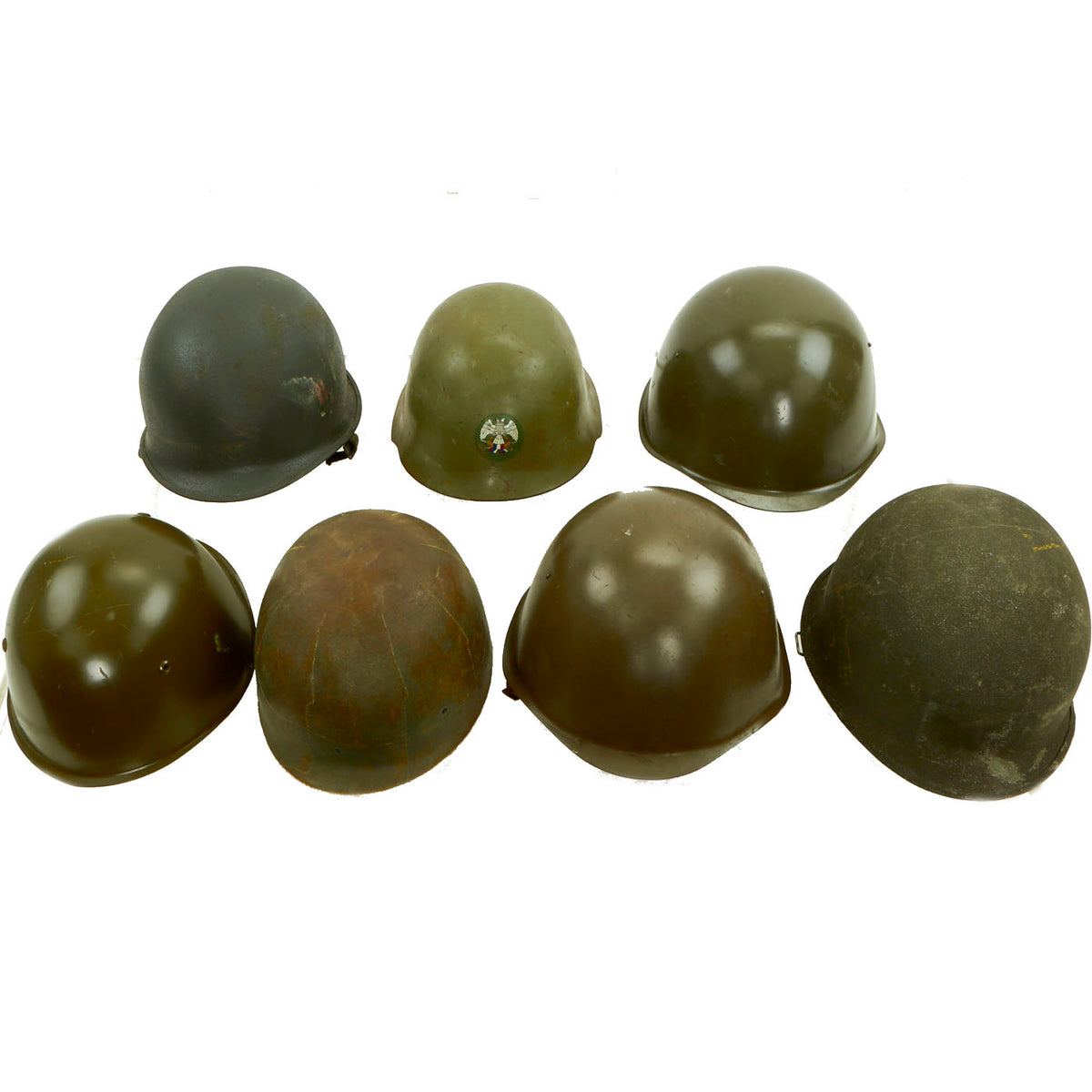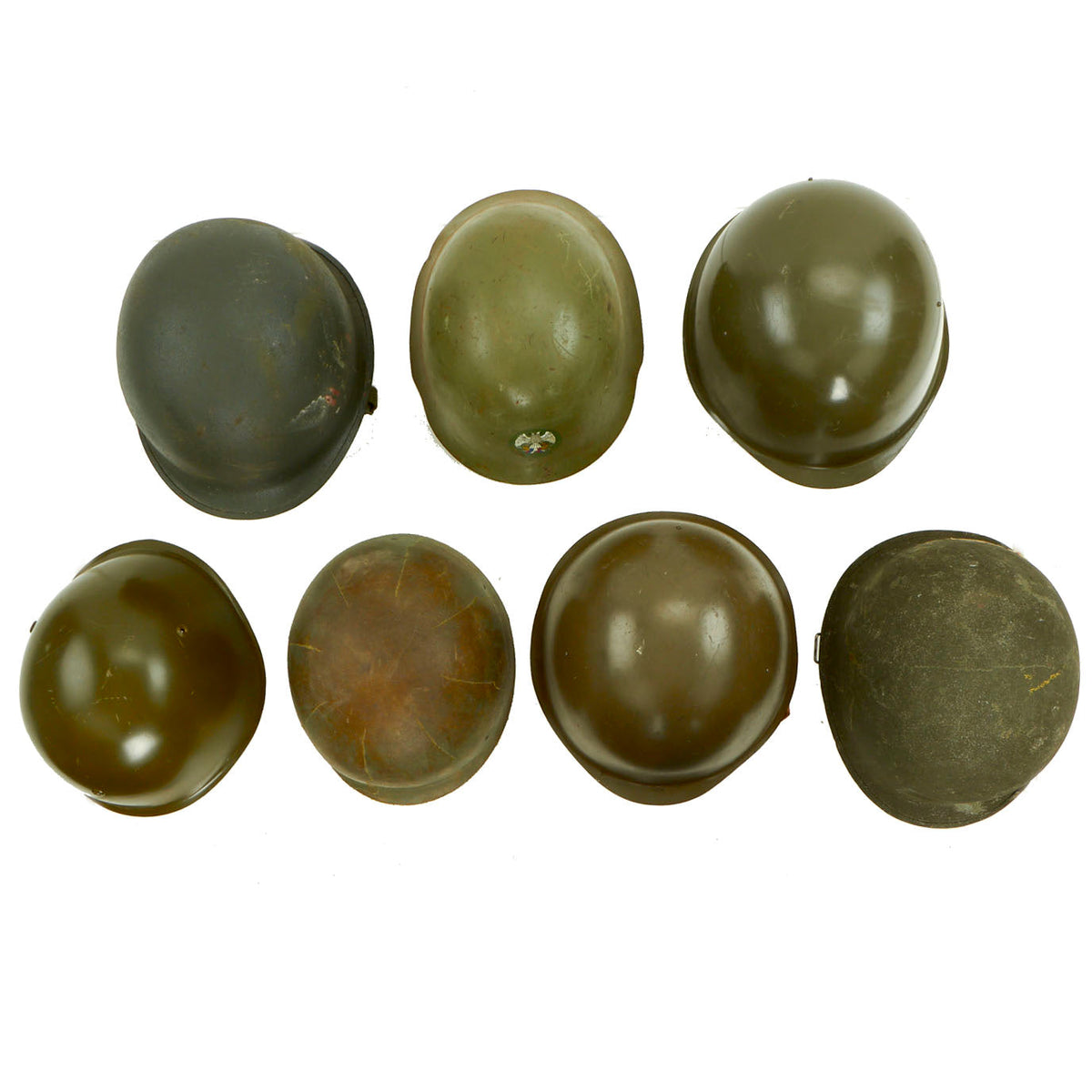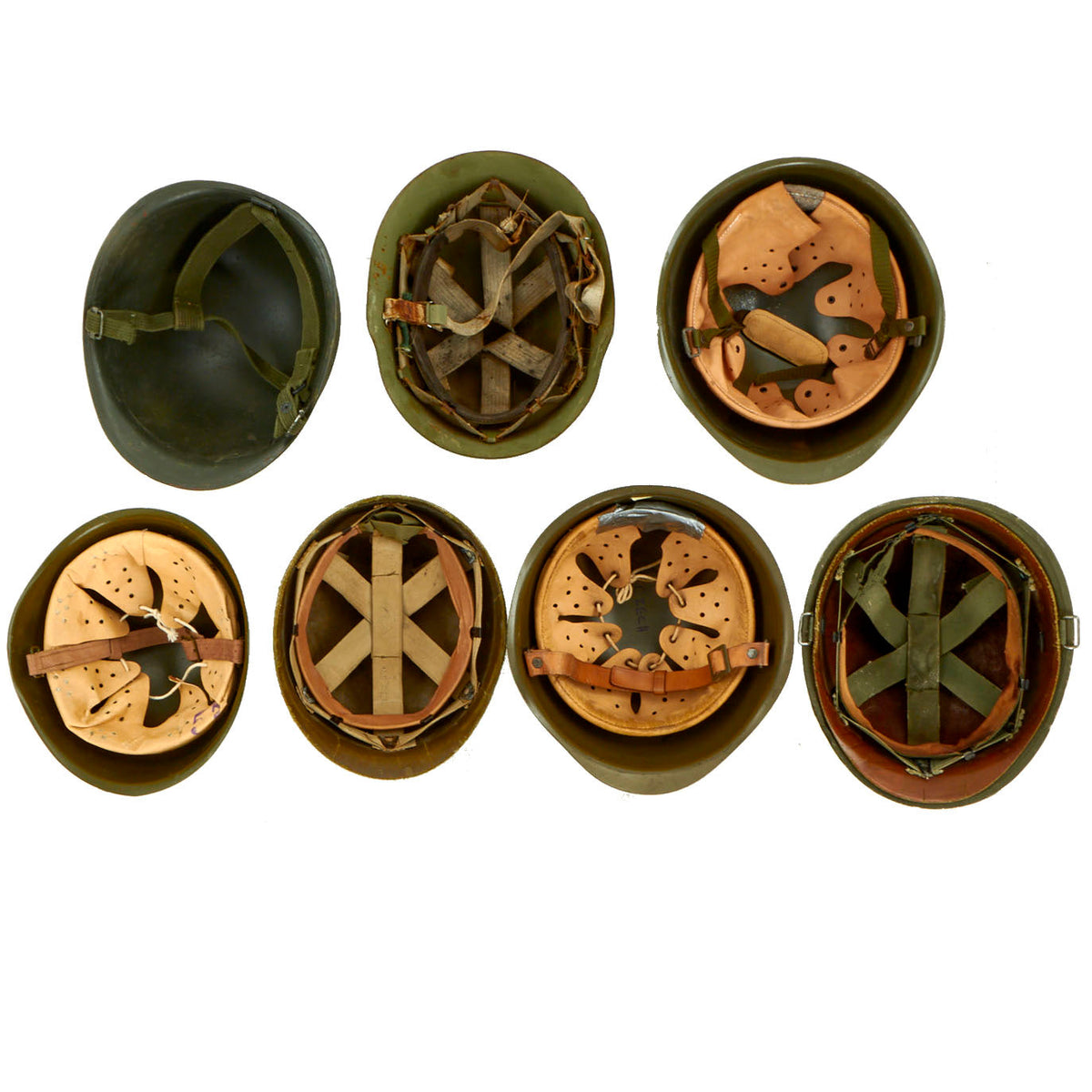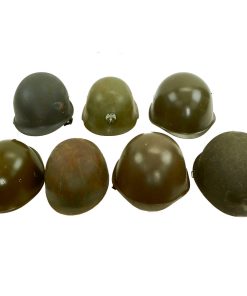Original Cold War Era Helmet Lot Featuring American, Iraqi and Eastern Bloc Nations – 6 Helmets Original Items
$ 225,00 $ 90,00
Original Items: Only One Set Available. This is a very nice collection of helmets from various time periods and countries. All helmets are complete with liners and are offered in great condition. This is a wonderful lot to pick up if you are looking to either start collecting helmets or are just wanting to add these really nice examples to your already existing ones.
The following five helmets are included in this lot:
U.S. Vietnam War Era M1 Helmet With Liner: The shell nor the liner have chinstraps present. The shell has the appearance of a WWII manufacture helmet with the corked paint, but lacks visible heat stamps. Great condition with minimal wear but does have minor bending to the stainless steel rim.
Israeli M1 Helmet Clone With Liner: The Israeli copy of the M1 helmet first saw service during the Six Day War in 1967, gradually phasing out the modified M51 and M1 helmets explained in a previous page. It sports a 3 point chinstrap that is obviously inspired from British paratrooper helmets from WW2, and an Israeli made liner that copies the US M1 helmet liners from the Vietnam war era. When compared side by side to a US M1 helmet, the shape and height of the Israeli M1 copy is significantly different. While this helmet is supposed to be entirely produced by Israel, some of the earliest ones produced were actually US made M1 helmets modified with the 3 point chinstrap. The Israeli M1 copy is commonly seen outfitted with an Israeli mesh net, an inner tube band, and/or a burlap cover. Lastly, this helmet was phased out by the M76 Orlite ballistic helmet in the early 1980’s. The liner appears to be a Middle Eastern Clone.
Yugoslavian/Serbian Military Surplus M59 & M59/85 Steel Helmet: These M59 and M59/85 helmets served the Yugo military for nearly three decades and continued to see use with the various countries that formed following the breakup of Yugoslavia, and are a truly unique design. This is genuine military surplus and will definitely show signs of age, use, storage, and/or general wear and tear. There is some minor damage including minor dents, rust, paint loss, scuffs, and scrapes.
Czechoslovakian Vz.52 Helmet: The Czechoslovakian M52 helmet was used by the Czechoslovak Army from the early 1950s onward. In western European countries and the United States, it is sometimes referred to as the Czech M53 helmet. These helmets are commonly mistaken for, and sometimes marketed as, Soviet SSh-40 helmets, and various other very similar Eastern Bloc helmets. As military souvenirs, Vz. 52 helmets may be marketed online as a ‘Soviet WW2 Helmet’ to appeal to consumers more.
Czechoslovakian M53 Helmet: The Czechoslovakian M53 helmet (Czech: Přilba vz. 53) was used by the Czechoslovak Army from the early 1950s onward. In western European countries and the United States, it is sometimes referred to as the Czech M53 helmet. These helmets are commonly mistaken for, and sometimes marketed as, Soviet SSh-40 helmets, and various other very similar Eastern Bloc helmets. The Vz. 53 incorporates designs from a variety of different countries, specifically Germany and the USSR. The shape of the shell is an exact copy of the Soviet SSh-39 and SSh-40 shell, and a very small percentage of helmets are actually SSh-40’s refitted with the Vz. 53’s leather liner. These are the original helmets sent to Czechoslovakia by the USSR in the early 1950s as a way to support their renewed military. The leather liner is a copy of the German Stahlhelm’s, which is a good way to tell it apart from other similar Eastern Bloc helmets.
Italian M33/47: Italian M33/47 Steel Combat Helmet, complete with liner and chinstrap. Worn by the Italian Army, and also by Albania and Yugoslavia for some number of years. The helmet is essentially an M33 but was postwar refitted with a better liner and chin strap. The M33 Helmet (Elmetto Mod. 33 in Italian) is a steel combat helmet designed in the 1930s in Italy, and was the standard combat helmet of the Regio Esercito up to World War II, and of the Esercito Italiano well into the Cold War.
All helmets come ready for research and display!
Combat Helmet
Helmets are among the oldest forms of personal protective equipment and are known to have been worn by the Akkadians/Sumerians in the 23rd century BC, Mycenaean Greeks since the 17th century BC, the Assyrians around 900 BC, ancient Greeks and Romans, throughout the Middle Ages, and up to the end of the 17th century by many combatants. Their materials and construction became more advanced as weapons became more and more powerful. Initially constructed from leather and brass, and then bronze and iron during the Bronze and Iron Ages, they soon came to be made entirely from forged steel in many societies after about 950 AD. At that time, they were purely military equipment, protecting the head from cutting blows with swords, flying arrows, and low-velocity musketry. Iron helmets were deployed into the cavalry of the Mali Empire to protect the cavalrymen and their mount.
Military use of helmets declined after 1670, and rifled firearms ended their use by foot soldiers after 1700 but the Napoleonic era saw ornate cavalry helmets reintroduced for cuirassiers and dragoons in some armies which continued to be used by French forces during World War I as late as 1915.
World War I and its increased use of artillery renewed the need for steel helmets, with the French Adrian helmet and the British Brodie helmet being the first modern steel helmets used on the battlefield, soon followed by the adoption of similar steel helmets, such as the Stahlhelm by the other warring nations. Such helmets offered protection for the head from shrapnel and fragments.
Today’s militaries often use high quality helmets made of ballistic materials such as Kevlar and Twaron, which offer improved protection. Some helmets also have good non-ballistic protective qualities, against threats such as concussive shock waves from explosions.
Many of today’s combat helmets have been adapted for modern warfare requirements and upgraded with STANAG rails to act as a platform for mounting cameras, video cameras and VAS Shrouds for the mounting of night vision goggles (NVG) and monocular night vision devices (NVD).
Beginning in the early 20th century, combat helmets have often been equipped with helmet covers to offer greater camouflage. There have been two main types of covers—mesh nets were earlier widely used, but most modern combat helmets use camouflage cloth covers instead.
By the late 20th century, starting in the 1970s and 1980s, new materials such as Kevlar and Twaron began replacing steel as the primary material for combat helmets, in an effort to improve weight, ballistics protection, and protection against head injuries caused by blasts. This practice still continues into the 21st century, with further advancement and refinements in the fibers used, design and shape of the helmet, and increased modularity. Early helmet systems of this new design are the American PASGT, the Spanish MARTE, the Italian SEPT-2 PLUS, and British Mk6.
Fast Shipping with Professional Packaging
Thanks to our longstanding association with UPS FedEx DHL, and other major international carriers, we are able to provide a range of shipping options. Our warehouse staff is expertly trained and will wrap your products according to our exact and precise specifications. Prior to shipping, your goods will be thoroughly examined and securely secured. We ship to thousands clients each day across multiple countries. This shows how we're dedicated to be the largest retailer on the internet. Warehouses and distribution centres can be located throughout Europe as well as the USA.
Note: Orders with more than one item will be assigned a processing date depending on the item.
Before shipping before shipping, we'll conduct a thorough inspection of the items you have ordered. Today, the majority of orders will be delivered within 48 hours. The delivery time will be between 3-7 days.
Returns
The stock is dynamic and we cannot completely manage it because multiple stakeholders are involved, including our factory and warehouse. So the actual stock may alter at any time. It's possible that you may not receive your order once the order has been made.
Our policy is valid for a period of 30 days. If you don't receive the product within 30 days, we are not able to issue a refund or an exchange.
You can only return an item if it is unused and in the same state as the day you received it. You must have the item in its original packaging.
Related products
Uncategorized
Uncategorized
Uncategorized
Uncategorized
Australian WWII Owen MK1 Machine Carbine SMG Custom Fabricated Replica with Sling Original Items
Uncategorized
Uncategorized
Band of Brothers ORIGINAL GERMAN WWII Le. F.H. 18 10.5cm ARTILLERY PIECE Original Items
Uncategorized
Angolan Rebel 1970s era 60mm Inert Display Mortar from Angolan Civil War Original Items
Uncategorized
Uncategorized
Uncategorized
Uncategorized
Uncategorized
Uncategorized
Armoured Fighting Vehicles of the World: AFVs of World War One (Hardcover Book) New Made Items
Uncategorized
Uncategorized
Uncategorized
Uncategorized
Uncategorized






































































